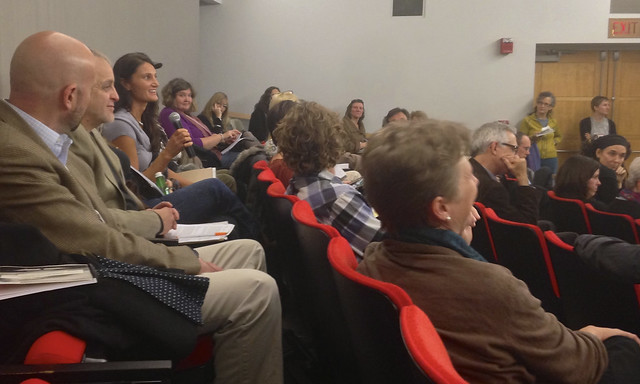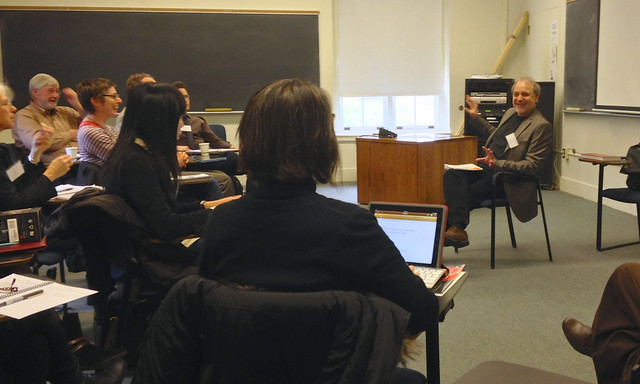The nearest airport is in Connecticut, so when your plane lands you still have a good long drive to get to Amherst. You talk to the shuttle driver. She has an accent you can’t place, but she’s lived in Massachusetts for at least a decade.
She drops you off at Allen House, a little bed and breakfast you found online. It proves to be a lovingly-done Victorian-era restoration, cozy and charming. The place is booked full of people from all over the world who are here for the same purpose as you. An instant and easy camaraderie springs up between you.
You’re here for the Fifth Annual Conference of the Association for Contemplative Mind in Higher Education (ACMHE), which is being held at Amherst College.
You make your way up the street to a noodle shop with a couple fellow travelers for a quick dinner. It’s cold, much colder than New Orleans, but only outdoors. You’re surprised to find that it’s warm and toasty indoors wherever you go. Apparently central heating is to New England what air conditioning is to the Deep South.
Then you walk over to Amherst College campus. The conference begins this evening. After registering at Converse Hall you find your way to Stirn Auditorium.
The ACMHE conference is a little different from other conferences, and that’s evident from the start. The opening plenary begins with silent meditation. There are a couple hundred people packed into the auditorium. Though no one says a word, you feel the power of their presence all the more. You are aware of the potentialities that will unfold over the next 40 hours.
If that wasn’t enough to distinguish this conference as unique, what comes next certainly seals the deal. An extra space has been reserved on the keynote panel. An audience member is randomly selected to fill it.
And so the conference begins. The theme this year is “Integrity of Practice.” The panel considers questions that revolve around this theme. Then the audience members discuss the questions amongst themselves, and finally share their thoughts with the larger group.
The next morning you have breakfast at the Amherst Inn, owned by the same people who run Allen House. The breakfast table serves as an extension of the conference, the conversations of the night before continuing over pancakes and coffee.
Very soon, you’re back on campus for the first of the parallel sessions. There are nine sessions running at the same time, and all the topics look fascinating. How to choose? You find yourself drawn to a session by David Forbes of Brooklyn College/CUNY, with the provocative title, “Contemplative Education and Neoliberalism: A Perfect World Still Requires Radical Action.”
Forbes’ presentation is chock-full of ideas, far more than even a fast-talking New Yorker can cover in the allotted time. He is asking all the right questions. “What is the purpose of contemplative practices in education? Is it enlightenment/awakening and the elimination of greed, ill-will, and delusion for everyone and at all societal levels, or is it a relativistic technology used to improve attention, reduce stress, and gain personal success and productivity in a competitive society?” The conversation that follows is galvanizing.
The morning continues. All the sessions look so promising that you decide to take a cue from the previous night’s panel and select your next session randomly. You end up listening to Ed Sarath from the University of Michigan hold forth on “Integrity of Practice in Meditation and Improvisation Pedagogy.”
You’re stunned to realize that improvisation has been perhaps the most central musical practice throughout world history, except for a period of about 200 years in Europe. This seems to throw light on the state of the modern academy, which even in America tends to be both highly traditional and Eurocentric. But that is changing.
You’ve come here from a historically Black university, so it is with special interest that you attend your next session, “Contemplative Race Theory: An Interdisciplinary Approach to Racial Discourse.” The presenters, Seth Schoen and Rev. Christopher Carter, seem very young. In fact, they are graduate students, and this is their first such presentation.
They present a “compassion practice” which they have developed together, a fairly advanced guided meditation that is grounded in critical race theory. It would seem to be a good way to prepare classes for difficult, sensitive or contentious discussions. They hope to publish on the practice soon. You make a note for future reference.
In the afternoon, there are open space sessions, organized around topics suggested by participants that very morning. You attend a discussion on race, class and gender.
The conversation is heartfelt, respectful yet challenging. You are taken by one participant’s observation that contemplation disrupts her “default modes of being,” which suggests the subtle potential of such practices for subverting engrained social structures.
The theme for the conference is “Integrity of Practice.” But your own personal theme is beginning to emerge. It might be called, “The Joy of Walking Slowly.” You find yourself walking often in the company of two women who walk slowly for different reasons. Karen is walking with a cane. Eileen simply seems to be the sort of person who is never rushed. You find you must make a conscious effort to slow down and stick with their pace, but this seems entirely in keeping with the spirit of the conference.
Before dinner on Saturday evening Karen reveals she doesn’t have a sprained ankle or a broken foot. She suffered a life-threatening stroke some while ago. You listen in awe to the story of her recovery, and how her 30-year practice of meditation helped her through a very difficult time.
It’s been a full day. You’re tired. You sleep like a rock that night, for about ten hours, disturbed only by a welcome nocturnal visitation from the B&B’s resident housecat.
Sunday morning begins in much the same manner as Saturday, with conversation around the breakfast table as stimulating as any one of the formal sessions. You walk to campus with Robert-Louis Abrahamson. When learning of your fascination with seasonal progress, he bestows upon you a touching gift: a copy of his own CD and accompanying booklet, Journey Through the Seasons, a cycle of meditations on the five Chinese healing energies.
You’re excited to attend a roundtable discussion on “The Role of Teaching Centers in Introducing and Supporting Contemplative Practices,” convened by your new friend Eileen Abrams.
A nascent faculty development network seems to be emerging. You know from previous experience how powerful this can be, and the exchange of ideas is invigorating. For example, one colleague suggests exploring the connection between contemplative pedagogy and retention rates. It seems like a promising line of inquiry.
But the best has, perhaps, been saved for last. The impromptu student panel was one of the most engaging sessions at the ACMHE conference. This was, in part, an opportunity for faculty to ask students, “What do we need to know from you?”
A number of new connections are made for you. For example: Metacognition is enhanced by meditation. We’ve sponsored workshops on both topics but never drawn that connection. You think to yourself: We should sponsor more student panels at CAT. We have much to learn from our students.
On the ride back to the airport, you find yourself once again conversing with the shuttle driver. He hails from Morocco and is a big fan of the Boston Celtics. As you describe the conference you discover what you’ve learned.
Pedagogy must connect course content to a larger whole; otherwise, we are merely conveying disassociated tidbits of information, quickly “crammed” into short-term memory and just as quickly forgotten. Pedagogy must be meaningful, purposeful, and connected to deep values in order to be effective and transformative. You’re struck by the awe-inspiring scope of this charge. You realize that this domain — the domain of meaning, purpose and values — provides a good working definition of spirituality. These issues are the main concern of many religions. Therefore, in order to be effective, teachers must be on a spiritual path or grounded in a spiritual practice. It’s not something extra, some “value added” proposition. It’s absolutely essential. It’s the core, the foundation of what we do. And it follows that a holistic faculty development program must provide support for the spiritual development of faculty members.
The implications are staggering. However will you communicate this to the folks back home?
Cross-posted at CAT Food (for thought)









I began reading your blog while working for a Katrina/Rita assistance program in Houston and really appreciate what you share about your community and life. I was so happy to see your return to writing here!